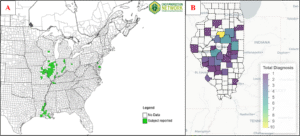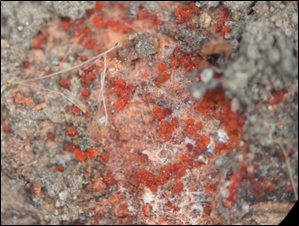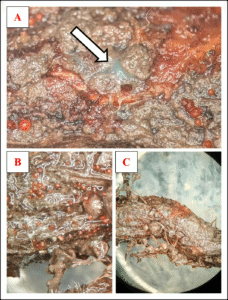From Rare to Relevant: Calonectria ilicicola and Its Growing Impact on Soybean Production in Illinois
Introduction
Red crown rot (RCR) of soybean is a disease caused by the fungal pathogen Calonectria ilicicola. This pathogen was first identified on peanuts in the United States in 1965 [1]. Since then, C. ilicicola has been found to cause disease in a wide variety of hosts across the world. It was first confirmed on soybeans in 1968 in Japan [2] and subsequently identified on soybeans in the United States in 1972 [3] in North Carolina. For several decades the disease was only observed in the southeastern United States, until it was identified in 2018 in Illinois [4] and has since been found in multiple Midwestern states (Figure 1). It has been confirmed in over 30 counties in Illinois, mostly in the southern and central areas of the state.

Symptoms and Signs
Red crown rot damages the roots and crown (lower stem) of soybean plants [5]. This can lead to stunting, wilting, and reduced yield. The fungus also produces a phytotoxin which causes leaf yellowing and necrosis [6]. Soybean fields typically appear healthy and green throughout the growing season. However, by late summer, leaf chlorosis (yellowing) and wilting begin to appear. RCR symptoms can easily be confused with those caused by other soybean diseases, which can make diagnosing RCR in the field difficult. The foliar symptoms are very similar to sudden death syndrome (SDS) and brown stem rot (BSR), since all these pathogens produce phytotoxins responsible for the interveinal yellow and brown discoloration. Stem discoloration can be confused with Phytophthora, Rhizoctonia, Fusarium, and stem canker diseases. In the field, affected plants tend to appear in patches, much like SDS, and may be stunted or weak, similar to Fusarium root rot and soybean cyst nematode infestations. Plants in lower lying areas, areas of compaction, and wetter soils are more prone to RCR [7], following a similar pattern to Phytophthora root and stem rot.
The causal agent of red crown rot is the fungus Calonectria ilicicola. It produces both sexual and asexual structures; when found in the asexual stage it was historically classified as Cylindrocladium.
Foliar symptoms include chlorosis (yellowing), typically occurring between the veins (Figure 2). This can progress to brown necrotic tissue and leaf death. Wilting and stunting are also commonly associated with this disease. RCR also causes root rot and red/brown discoloration of the lower stem near the soil line (Figure 3).


Calonectria ilicicola produces red perithecia (sexual fruiting structures) and/or white masses of conidia (asexual spores) which may develop on the lower stem under favorable environmental conditions (Figures 4 and 5).


Unfortunately, other fungi may produce similar structures, making diagnosing red crown rot (RCR) in the field challenging. Many of the symptoms and signs associated with RCR are nonspecific and can be easily mistaken for those caused by other pathogens [8]. Furthermore, co-infections with multiple pathogens are common, often resulting in overlapping or confounding symptom expression that complicates accurate field diagnosis (Figures 6 and 7).


Laboratory Diagnosis
The diagnosis of red crown rot in the laboratory begins with a visual assessment of the characteristic symptoms caused by the disease. This is supported by information provided by the client, such as the distribution of symptomatic plants in the field, weather conditions prior to symptom development, the cultivar planted, and any fungicide applications (see the Plant Clinic Diagnostic Submission Form). Following this, a detailed microscopic examination of the stem and roots is conducted to identify pathogen structures present.
Samples are often incubated in moisture chambers, creating an environment of high humidity. These conditions are favorable for the development of diagnostic structures, such as perithecia and their ascospores, and conidia (Figure 8). Samples may also be cultured to isolate pure cultures of the pathogen (Figure 9).


Management
The first step to managing any plant health issue is to confirm the cause of the symptoms noted. As noted above, there are numerous biotic and abiotic factors that contribute to visible plant symptomology, which can make accurately diagnosing these issues difficult in the field. Submitting whole-plant samples dug out of the ground allows diagnosticians at the University of Illinois Plant Clinic to assess field crops for root, stem, stalk, leaf, and seed diseases and pests. Final reports detail all pests and pathogens found on the sample, along with management recommendations. For more information, please visit our website: https://extension.illinois.edu/plant-clinic
If red crown rot is confirmed in your field:
- Consider using a seed treatment product recommended for the management of red crown rot. Options include Saltro (pydiflumetofen; Syngenta) and ILeVO (fluopyram; BASF)), both of which have FIFRA 2(ee) labels for suppression of RCR.
- Avoid soil compaction and maintain field vigor through proper fertilization, pest control, and overall disease management practices.
- Wash equipment thoroughly before moving from infested fields to non-infested fields to reduce the risk of spreading pathogen survival structures in soil.
Current and Future Work
Greenhouse and field trials are essential for testing new disease management strategies, including plant resistance, fungicide timing and efficacy, and cultural practices such as tillage.
The Plant Clinic produces grain and plate inoculum, including for red crown rot, to help stakeholders evaluate the effectiveness of new crop protection chemistries and disease resistance genetics against this disease (Figures 10 and 11). Inoculating fields is important, since it ensures that the pathogen being tested is present, ubiquitous throughout the trial area, and in an infectious stage. If this is not done, natural variation in disease pressure within a trial area, between different trial areas, and from one year to the next can complicate the interpretation of trial results.


Our team is actively conducting field trials at five locations across Illinois to evaluate soybean variety susceptibility, assess the performance of seed treatments, and test in-furrow and 2×2 fungicide applications, including both chemical and biological products. We are also beginning to screen other agronomic practices to identify the field conditions that favor disease occurrence, which will guide management recommendations for farmers. In addition, we are leading a remote sensing project that integrates UAV and satellite imagery to map disease distribution within fields, enabling early detection and precision management. We are also developing nanofungicide formulations designed to increase the efficacy and longevity of current fungicides. To support these field efforts, we are refining greenhouse and pot experiment protocols to establish optimal conditions and parameters for screening soybean lines and management practices under controlled environments.
To strengthen these efforts, we are seeking additional fields confirmed with RCR in order to improve the accuracy and efficacy of our AI models for disease detection with remote sensing. Farmers and agronomists who suspect or confirm RCR in their fields are encouraged to confidentially share this information with Dr. Boris X. Camiletti (UIUC), at bxc@illinois.edu, with the assurance that all details will be kept strictly confidential.
For questions about plant sampling, laboratory diagnostics, pest and pathogen management, or inoculum, contact the University of Illinois Plant Clinic at 217-333-0519 or email plantclinic@illinois.edu.
Author contacts: Esneider Mahecha Bojaca (esmabo@illinois.edu ), Diane Plewa (dplewa@illinois.edu) and Boris X Camiletti (bxc@illinois.edu). Reviewed by: Talon Becker (tbecker2@illinois.edu).

The pictures in this article are from samples that were received in the Plant Clinic. All pictures are copyright University of Illinois Plant Clinic.
The University of Illinois Plant Clinic is an Extension program housed in the Department of Crop Sciences and a member of the National Plant Diagnostic Network.
References
- Bel, D. and Sobers, K. A Peg, Pod, and Root Necrosis of Peanuts Caused by a Species of Calonectria. Agriculture and Food Sciences.
- Nishi, K. Present situation on Calonectria root rot of soybean [in Japan]. Journal of Agricultural Science (Japan). 44:2. 70-75.
- Rowe, R.C., Beute, M.K., and Wells, J.C. Cylindrocladium black rot of peanuts in North Carolina – 1972. Plant Disease Reporter. 57:5.
- Kleczewski, N., Plewa, D., Kangas, C., Phillippi, E., and Kleczewski, V. First Report of Red Crown Rot of Soybeans Caused by Calonectria ilicicola (Anamorph: Cylindrocladium parasiticum) in Illinois. Plant Disease. 103:7. doi: 10.1094/PDIS-01-19-0105-PDN
- Kobayashi, M., Win, K.T., and Jiang, C.J. Soybean Hypocotyls Prevent Calonectria ilicicola Invasion by Multi-Layered Defenses. Front. Plant Sci. 2022. doi: 3389/fpls.2021.813578
- Ochi, S., Yoshida, M., Nakagawa, A., and Natsume, M. Identification and activity of a phytotoxin produced by Calonectria ilicicola, the causal agent of soybean red crown rot. J. of Plant Pathol. 2011. 33:347-354. doi: 10.1080/07060661.2011.593558
- Crop Protection Network. https://cropprotectionnetwork.org/encyclopedia/red-crown-rot-of-soybean. Cited 18 September 2025.
- Crop Protection Network. https://cropprotectionnetwork.org/publications/scouting-for-soybean-stem-diseases. Cited 23 September 2025.





